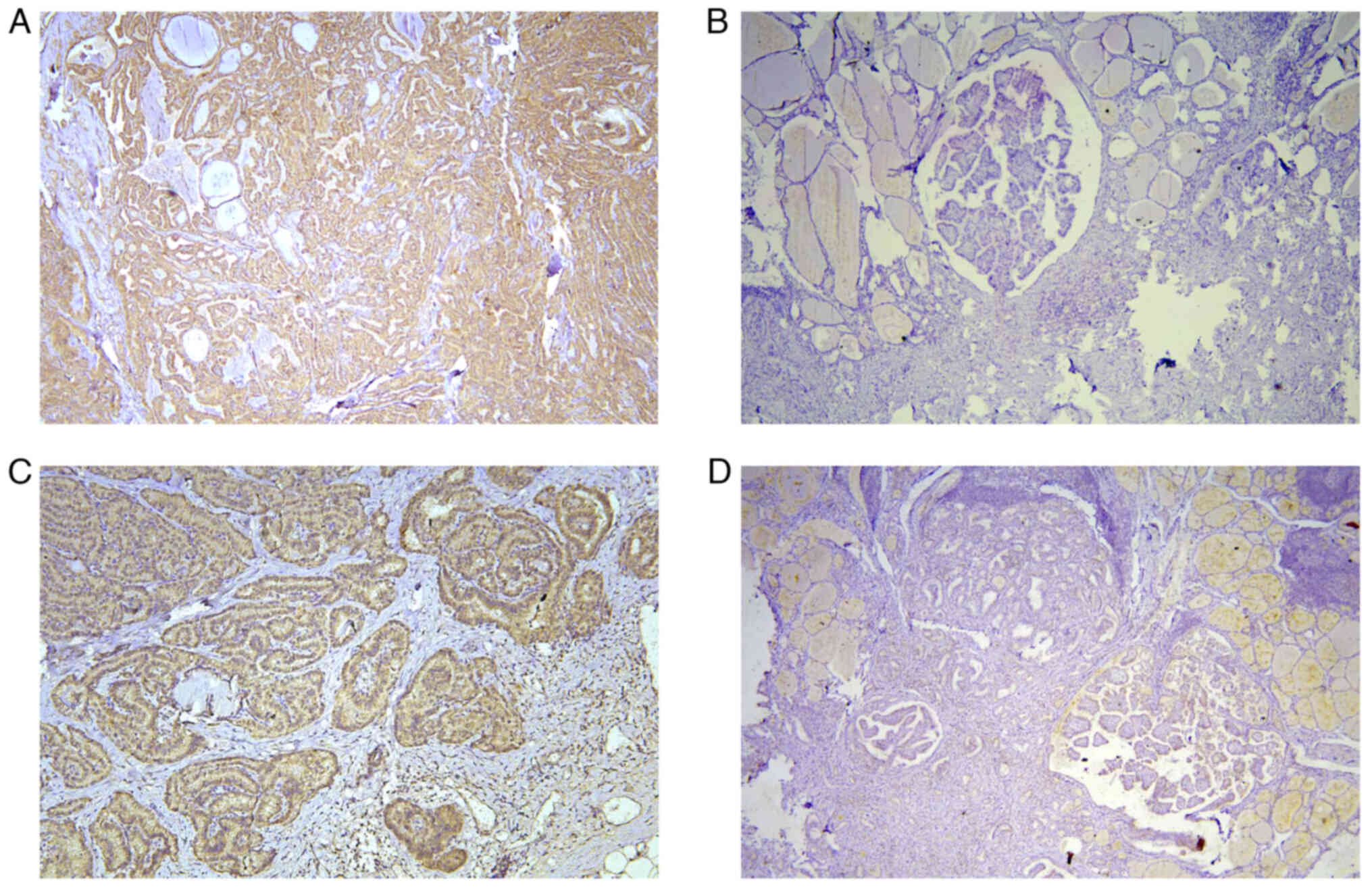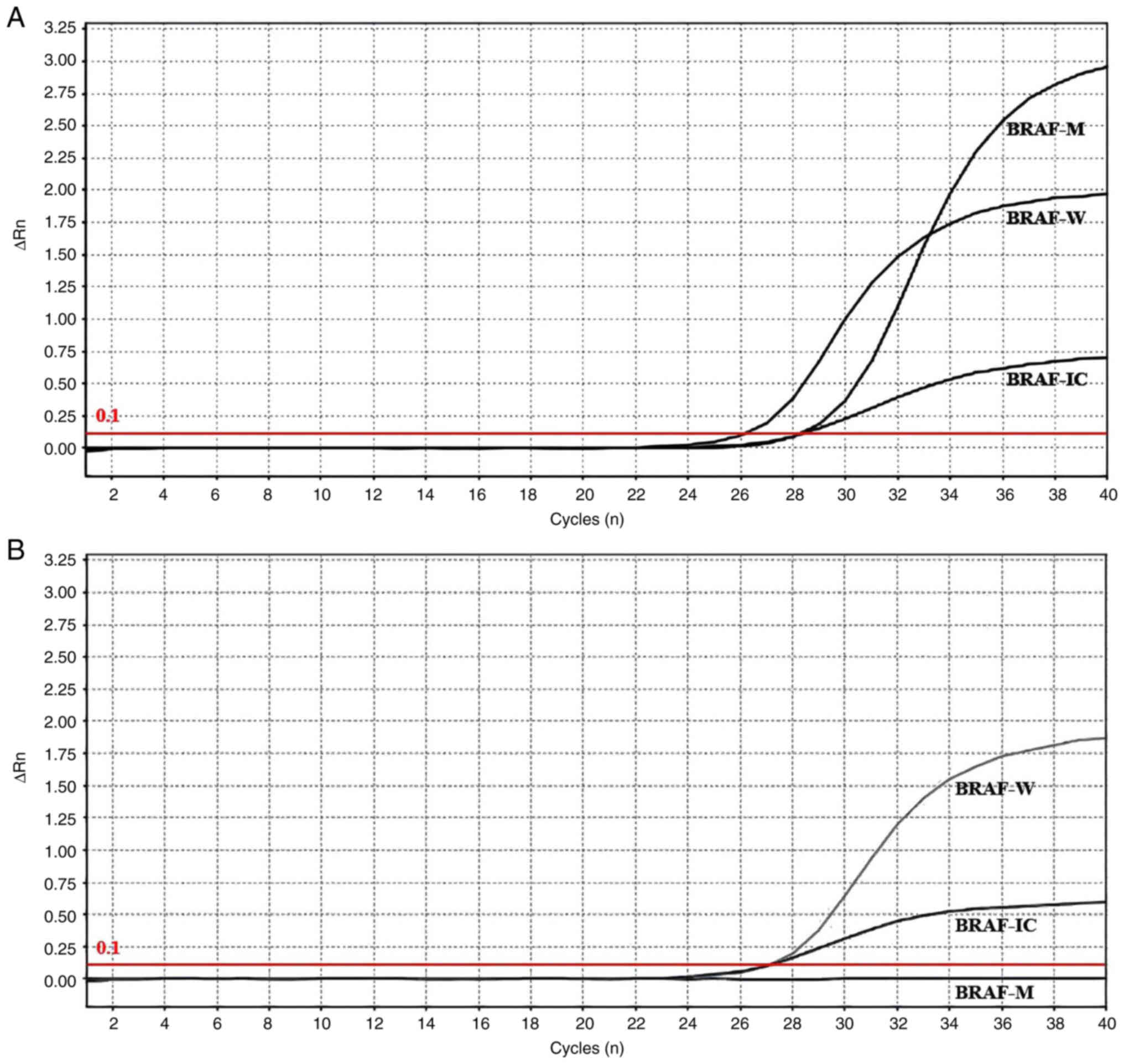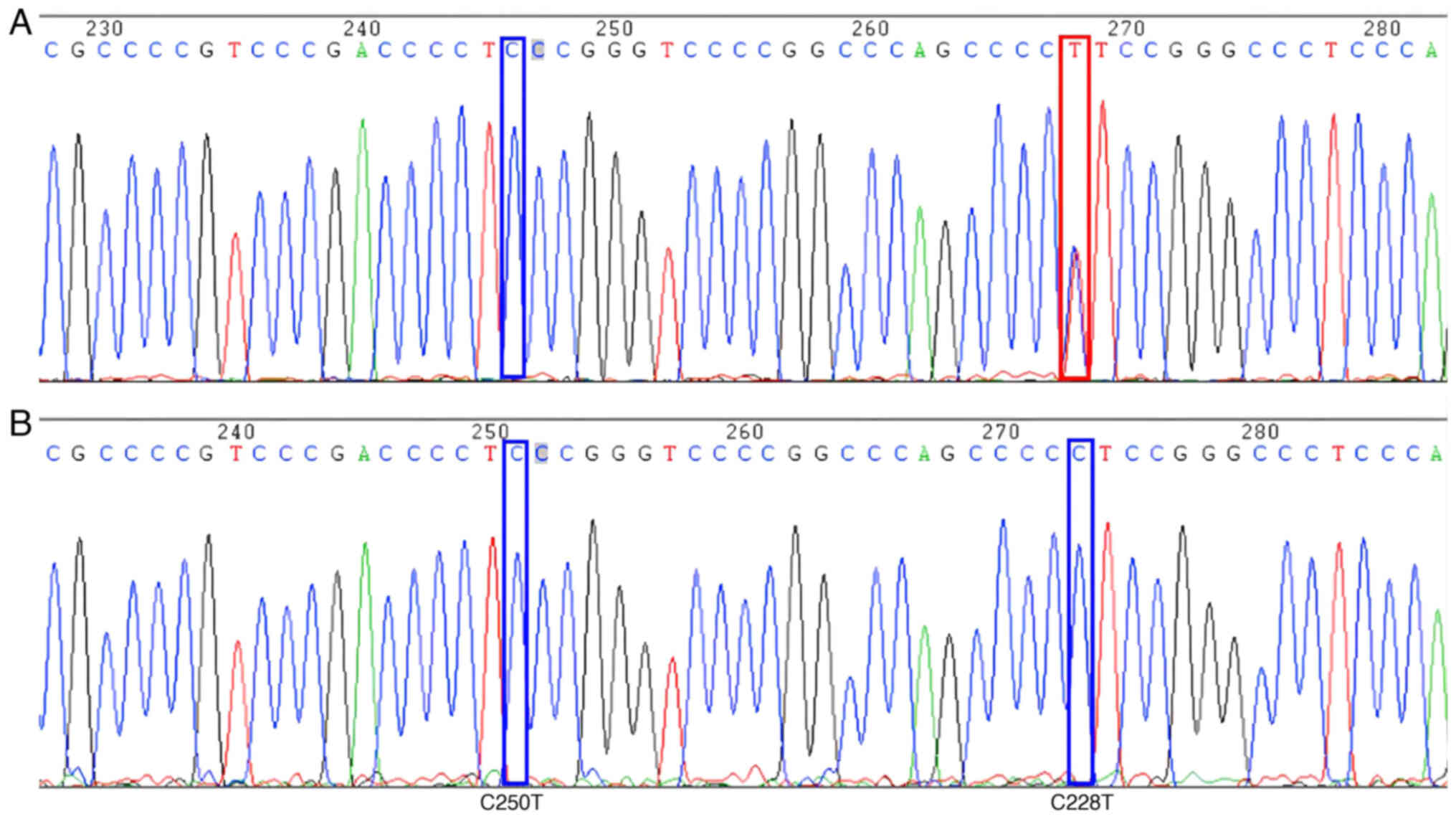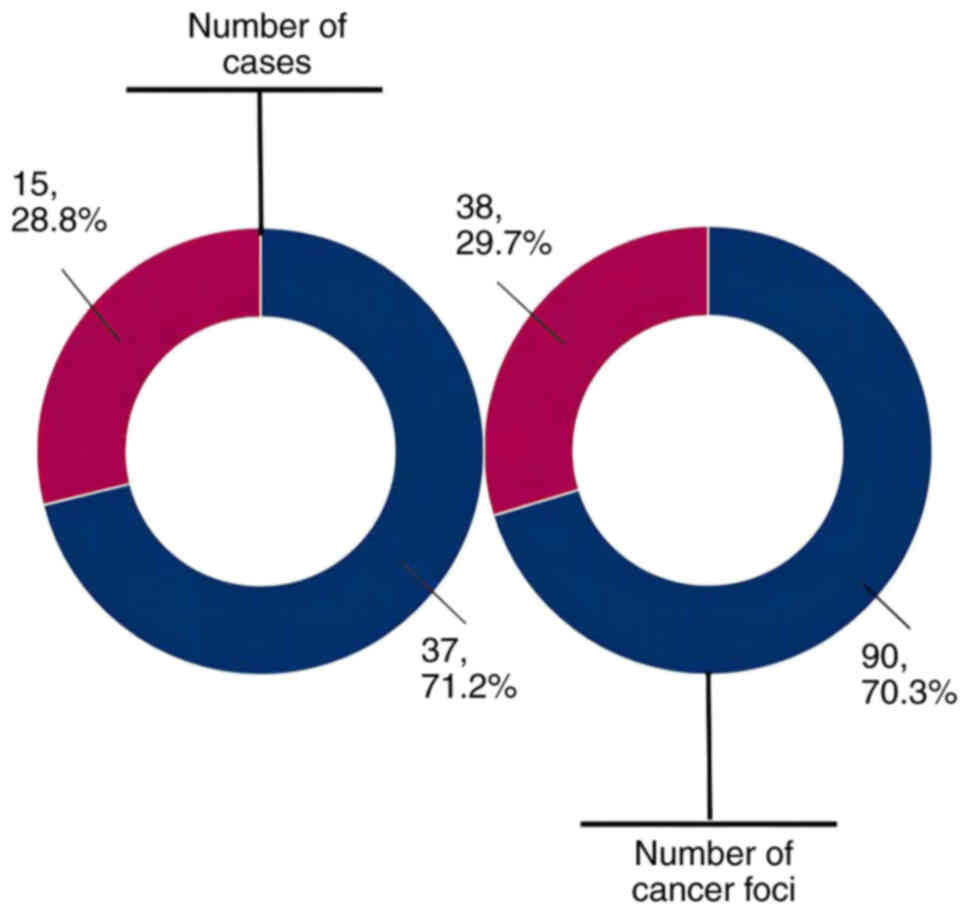|
1
|
Choi WR, Roh JL, Gong G, Cho KJ, Choi SH,
Nam SY and Kim SY: Multifocality of papillary thyroid carcinoma as
a risk factor for disease recurrence. Oral Oncol. 94:106–110. 2019.
View Article : Google Scholar : PubMed/NCBI
|
|
2
|
Zhang JW, Fei MJ, Hou YQ, Tang ZY, Zhan WW
and Zhou JQ: Long-term follow-up ultrasonography surveillance in a
large cohort of patients with papillary thyroid carcinoma.
Endocrine. 77:297–304. 2022. View Article : Google Scholar : PubMed/NCBI
|
|
3
|
Chen W, Zheng R, Baade PD, Zhang S, Zeng
H, Bray F, Jemal A, Yu XQ and He J: Cancer statistics in China,
2015. CA Cancer J Clin. 66:115–132. 2016. View Article : Google Scholar : PubMed/NCBI
|
|
4
|
Zheng RS, Chen R, Han BF, Wang SM, Li L,
Sun KX, Zeng HM, Wei WW and He J: Cancer incidence and mortality in
China, 2022. Zhonghua Zhong Liu Za Zhi. 46:221–231. 2024.(In
Chinese). PubMed/NCBI
|
|
5
|
Li M, Zheng R, Dal Maso L, Zhang S, Wei W
and Vaccarella S: Mapping overdiagnosis of thyroid cancer in China.
Lancet Diabetes Endocrinol. 9:330–332. 2021. View Article : Google Scholar : PubMed/NCBI
|
|
6
|
Li M, Dal Maso L and Vaccarella S: Global
trends in thyroid cancer incidence and the impact of overdiagnosis.
Lancet Diabetes Endocrinol. 8:468–470. 2020. View Article : Google Scholar : PubMed/NCBI
|
|
7
|
Vaccarella S, Franceschi S, Bray F, Wild
CP, Plummer M and Dal Maso L: Worldwide thyroid-cancer epidemic?
The increasing impact of overdiagnosis. N Engl J Med. 375:614–617.
2016. View Article : Google Scholar : PubMed/NCBI
|
|
8
|
Dal Maso L, Panato C, Franceschi S,
Serraino D, Buzzoni C, Busco S, Ferretti S, Torrisi A, Falcini F,
Zorzi M, et al: The impact of overdiagnosis on thyroid cancer
epidemic in Italy, 1998–2012. Eur J Cancer. 94:6–15. 2018.
View Article : Google Scholar : PubMed/NCBI
|
|
9
|
Roman BR, Morris LG and Davies L: The
thyroid cancer epidemic, 2017 perspective. Curr Opin Endocrinol
Diabetes Obes. 24:332–336. 2017. View Article : Google Scholar : PubMed/NCBI
|
|
10
|
Kiriakopoulos A, Petralias A and Linos D:
Multifocal versus solitary papillary thyroid carcinoma. World J
Surg. 40:2139–2143. 2016. View Article : Google Scholar : PubMed/NCBI
|
|
11
|
Cui L, Feng D, Zhu C, Li Q, Li W and Liu
B: Clinical outcomes of multifocal papillary thyroid cancer: A
systematic review and meta-analysis. Laryngoscope Investig
Otolaryngol. 7:1224–1234. 2022. View
Article : Google Scholar : PubMed/NCBI
|
|
12
|
Park SY, Park YJ, Lee YJ, Lee HS, Choi SH,
Choe G, Jang HC, Park SH, Park DJ and Cho BY: Analysis of
differential BRAF(V600E) mutational status in multifocal papillary
thyroid carcinoma: Evidence of independent clonal origin in
distinct tumor foci. Cancer. 107:1831–1838. 2006. View Article : Google Scholar : PubMed/NCBI
|
|
13
|
Bansal M, Gandhi M, Ferris RL, Nikiforova
MN, Yip L, Carty SE and Nikiforov YE: Molecular and histopathologic
characteristics of multifocal papillary thyroid carcinoma. Am J
Surg Pathol. 37:1586–1591. 2013. View Article : Google Scholar : PubMed/NCBI
|
|
14
|
McCarthy RP, Wang M, Jones TD, Strate RW
and Cheng L: Molecular evidence for the same clonal origin of
multifocal papillary thyroid carcinomas. Clin Cancer Res.
12:2414–2418. 2006. View Article : Google Scholar : PubMed/NCBI
|
|
15
|
Kuhn E, Teller L, Piana S, Rosai J and
Merino MJ: Different clonal origin of bilateral papillary thyroid
carcinoma, with a review of the literature. Endocr Pathol.
23:101–107. 2012. View Article : Google Scholar : PubMed/NCBI
|
|
16
|
Nikiforova MN and Nikiforov YE: Molecular
genetics of thyroid cancer: Implications for diagnosis, treatment
and prognosis. Expert Rev Mol Diagn. 8:83–95. 2008. View Article : Google Scholar : PubMed/NCBI
|
|
17
|
Liu R and Xing M: TERT promoter mutations
in thyroid cancer. Endocr Relat Cancer. 23:R143–R155. 2016.
View Article : Google Scholar : PubMed/NCBI
|
|
18
|
Czarniecka A, Oczko-Wojciechowska M and
Barczyński M: BRAF V600E mutation in prognostication of papillary
thyroid cancer (PTC) recurrence. Gland Surg. 5:495–505. 2016.
View Article : Google Scholar : PubMed/NCBI
|
|
19
|
Rashid FA, Munkhdelger J, Fukuoka J and
Bychkov A: Prevalence of BRAFV600E mutation in Asian
series of papillary thyroid carcinoma-a contemporary systematic
review. Gland Surg. 9:1878–1900. 2020. View Article : Google Scholar : PubMed/NCBI
|
|
20
|
Calado RT: Telomeres and marrow failure.
Hematology Am Soc Hematol Educ Program. 1:338–343. 2009. View Article : Google Scholar : PubMed/NCBI
|
|
21
|
Vuong HG, Altibi AMA, Duong UNP and
Hassell L: Prognostic implication of BRAF and TERT promoter
mutation combination in papillary thyroid carcinoma-a
meta-analysis. Clin Endocrinol (Oxf). 87:411–417. 2017. View Article : Google Scholar : PubMed/NCBI
|
|
22
|
Tam AA, Özdemir D, Çuhacı N, Başer H,
Aydın C, Yazgan AK, Ersoy R and Çakır B: Association of
multifocality, tumor number, and total tumor diameter with
clinicopathological features in papillary thyroid cancer.
Endocrine. 53:774–783. 2016. View Article : Google Scholar : PubMed/NCBI
|
|
23
|
Feng JW, Wu WX, Hu J, Hong LZ, Qin AC,
Jiang Y and Ye J: Influence of tumor number on clinicopathologic
features and outcomes of patients with papillary thyroid carcinoma.
Am J Clin Pathol. 154:848–858. 2020. View Article : Google Scholar : PubMed/NCBI
|
|
24
|
Qu N, Zhang L, Ji QH, Zhu YX, Wang ZY,
Shen Q, Wang Y and Li DS: Number of tumor foci predicts prognosis
in papillary thyroid cancer. BMC Cancer. 14:9142014. View Article : Google Scholar : PubMed/NCBI
|
|
25
|
Kim H, Kwon H and Moon BI: Association of
multifocality with prognosis of papillary thyroid carcinoma: A
systematic review and meta-analysis. JAMA Otolaryngol Head Neck
Surg. 147:847–854. 2021. View Article : Google Scholar : PubMed/NCBI
|
|
26
|
Feng JW, Qu Z, Qin AC, Pan H, Ye J and
Jiang Y: Significance of multifocality in papillary thyroid
carcinoma. Eur J Surg Oncol. 46:1820–1828. 2020. View Article : Google Scholar : PubMed/NCBI
|
|
27
|
Lin JD, Chao TC, Hsueh C and Kuo SF: High
recurrent rate of multicentric papillary thyroid carcinoma. Ann
Surg Oncol. 16:2609–2616. 2009. View Article : Google Scholar : PubMed/NCBI
|
|
28
|
Woo J, Kim H and Kwon H: Impact of
multifocality on the recurrence of papillary thyroid carcinoma. J
Clin Med. 10:51442021. View Article : Google Scholar : PubMed/NCBI
|
|
29
|
Muzza M: The clonal origin of multifocal
papillary thyroid cancer: Intrathyroidal spread or independent
tumors? Minerva Endocrinol (Torino). 46:35–44. 2021.PubMed/NCBI
|
|
30
|
Chen D, Qi W, Xie S, Feng L, Wang J, Wang
L and Guan H: Investigation of the clonal origin of multifocal
papillary thyroid carcinoma according to the X-chromosome
inactivation pattern. Oncol Lett. 17:4695–4700. 2019.PubMed/NCBI
|
|
31
|
Jovanovic L, Delahunt B, McIver B,
Eberhardt NL and Grebe SK: Most multifocal papillary thyroid
carcinomas acquire genetic and morphotype diversity through
subclonal evolution following the intra-glandular spread of the
initial neoplastic clone. J Pathol. 215:145–154. 2008. View Article : Google Scholar : PubMed/NCBI
|
|
32
|
Nakazawa T, Kondo T, Tahara I, Kasai K,
Inoue T, Oishi N, Mochizuki K, Kubota T and Katoh R: Multicentric
occurrence of multiple papillary thyroid carcinomas-HUMARA and BRAF
mutation analysis. Cancer Med. 4:1272–1280. 2015. View Article : Google Scholar : PubMed/NCBI
|
|
33
|
Lin X, Finkelstein SD, Zhu B and Silverman
JF: Molecular analysis of multifocal papillary thyroid carcinoma. J
Mol Endocrinol. 41:195–203. 2008. View Article : Google Scholar : PubMed/NCBI
|
|
34
|
Lu Z, Sheng J, Zhang Y, Deng J, Li Y, Lu
A, Zhang J, Yu H, Zhang M, Xiong Z, et al: Clonality analysis of
multifocal papillary thyroid carcinoma by using genetic profiles. J
Pathol. 239:72–83. 2016. View Article : Google Scholar : PubMed/NCBI
|
|
35
|
Shattuck TM, Westra WH, Ladenson PW and
Arnold A: Independent clonal origins of distinct tumor foci in
multifocal papillary thyroid carcinoma. N Engl J Med.
352:2406–2412. 2005. View Article : Google Scholar : PubMed/NCBI
|
|
36
|
Trimboli P, Piccardo A, Signore A,
Valabrega S, Barnabei A, Santolamazza G, Di Paolo A, Stati V,
Chiefari A, Vottari S, et al: Patient age is an independent risk
factor of relapse of differentiated thyroid carcinoma and improves
the performance of the American Thyroid Association stratification
system. Thyroid. 30:713–719. 2020. View Article : Google Scholar : PubMed/NCBI
|
|
37
|
Nixon IJ, Kuk D, Wreesmann V, Morris L,
Palmer FL, Ganly I, Patel SG, Singh B, Tuttle RM, Shaha AR, et al:
Defining a valid age cutoff in staging of welldifferentiated
thyroid cancer. Ann Surg Oncol. 23:410–415. 2016. View Article : Google Scholar : PubMed/NCBI
|
|
38
|
Mazzaferri EL and Kloos RT: Clinical
review 128: Current approaches to primary therapy for papillary and
follicular thyroid cancer. J Clin Endocrinol Metab. 86:1447–1463.
2001. View Article : Google Scholar : PubMed/NCBI
|
|
39
|
Voutilainen PE, Siironen P, Franssila KO,
Sivula A, Haapiainen RK and Haglund CH: AMES, MACIS and TNM
prognostic classifications in papillary thyroid carcinoma.
Anticancer Res. 23:4283–4288. 2003.PubMed/NCBI
|
|
40
|
Sun Y, Dai W, Liang Y and Xia N: Impact of
age on the prognosis of papillary thyroid carcinoma. Arch Iran Med.
23:169–174. 2020.PubMed/NCBI
|
|
41
|
Ito Y, Kudo T, Kobayashi K, Miya A,
Ichihara K and Miyauchi A: Prognostic factors for recurrence of
papillary thyroid carcinoma in the lymph nodes, lung, and bone:
Analysis of 5,768 patients with average 10-year follow-up. World J
Surg. 36:1274–1278. 2012. View Article : Google Scholar : PubMed/NCBI
|
|
42
|
Soylu L, Aydin OU, Ozbas S, Bilezikci B,
Ilgan S, Gursoy A and Kocak S: The impact of the multifocality and
subtypes of papillary thyroid carcinoma on central compartment
lymph node metastasis. Eur Rev Med Pharmacol Sci. 20:3972–3979.
2016.PubMed/NCBI
|
|
43
|
Genpeng L, Jianyong L, Jiaying Y, Ke J,
Zhihui L, Rixiang G, Lihan Z and Jingqiang Z: Independent
predictors and lymph node metastasis characteristics of multifocal
papillary thyroid cancer. Medicine (Baltimore). 97:e96192018.
View Article : Google Scholar : PubMed/NCBI
|
|
44
|
Kim HJ, Sohn SY, Jang HW, Kim SW and Chung
JH: Multifocality, but not bilaterality, is a predictor of disease
recurrence/persistence of papillary thyroid carcinoma. World J
Surg. 37:376–384. 2013. View Article : Google Scholar : PubMed/NCBI
|
|
45
|
Pancer J, Mitmaker E, Ajise O, Tabah R and
How J: A thyroid gland with over 30 foci of papillary thyroid
carcinoma with activating BRAF V600E mutation. Endocrinol Diabetes
Metab Case Rep. 19:19–0006. 2019.PubMed/NCBI
|
|
46
|
Choi Y, Park KJ, Ryu S, Kim DH, Yun J,
Kang DK and Chun M: Papillary thyroid carcinoma involving cervical
neck lymph nodes: Correlations with lymphangiogenesis and
ultrasound features. Endocr J. 59:941–948. 2012. View Article : Google Scholar : PubMed/NCBI
|
|
47
|
Dong S, Xie XJ, Xia Q and Wu YJ:
Indicators of multifocality in papillary thyroid carcinoma
concurrent with Hashimoto's thyroiditis. Am J Cancer Res.
9:1786–1795. 2019.PubMed/NCBI
|
|
48
|
Zhao J and Luo Z: Discovery of Raf family
is a milestone in deciphering the Ras-mediated intracellular
signaling pathway. Int J Mol Sci. 23:51582022. View Article : Google Scholar : PubMed/NCBI
|
|
49
|
Russo M, Malandrino P, Nicolosi ML,
Manusia M, Marturano I, Trovato MA, Pellegriti G, Frasca F and
Vigneri R: The BRAF(V600E) mutation influences the short-and
medium-term outcomes of classic papillary thyroid cancer but is not
an independent predictor of unfavorable outcome. Thyroid.
24:1267–1274. 2014. View Article : Google Scholar : PubMed/NCBI
|
|
50
|
Jing C, Cao H, Ma R, Wu J and Wang Z:
Association between mutation profiles and clinicopathological
features in Chinese patients with thyroid cancer. Precision Medical
Sciences. 10:113–117. 2021. View Article : Google Scholar
|
|
51
|
Yu P, Qu N, Zhu R, Hu J, Han P, Wu J, Tan
L, Gan H, He C, Fang C, et al: TERT accelerates BRAF mutant-induced
thyroid cancer dedifferentiation and progression by regulating
ribosome biogenesis. Science Adv. 9:eadg71252023. View Article : Google Scholar : PubMed/NCBI
|













